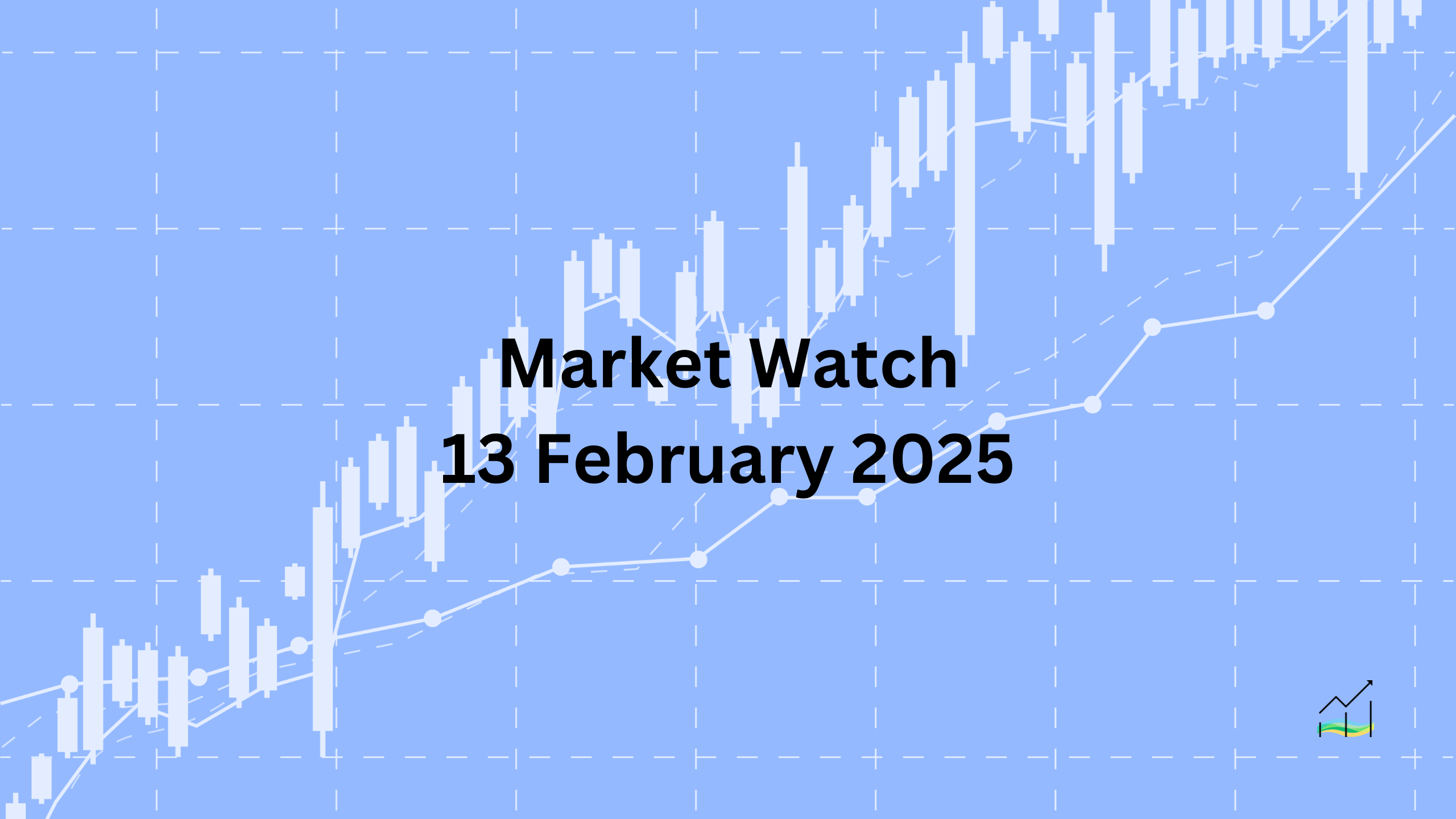13/02/2025 Market Watch

European Currencies Gain, Dollar Struggles
European currencies gained momentum after Donald Trump reported productive discussions with Vladimir Putin on a potential Ukraine ceasefire. While this rally may extend further, upside for EUR/USD remains limited due to concerns over potential US tariffs on Europe and persistent US inflation keeping interest rates elevated.
In the Asian session, forex markets remained subdued. The US dollar initially strengthened on higher-than-expected inflation data but quickly lost momentum. While the dollar maintains gains against the yen, it has weakened against other major currencies. The inability of the dollar to sustain its rally—despite fading expectations of a Fed rate cut in the first half of 2025 and ongoing tariff risks—raises the possibility of further declines ahead.
With US inflation data now priced in, market attention shifts to the UK, where Q4 GDP figures are expected to show a -0.1% quarterly contraction, though December could see slight growth of 0.1% month-on-month. The think tank NIESR remains cautiously optimistic, forecasting slow growth in early 2025 before an acceleration later in the year, with GDP expected to expand by 1.5%, supported by higher government spending and business investment.
So far this week, the euro leads as the strongest performer, followed by the British pound and Australian dollar. The yen remains the weakest, with the Swiss franc and New Zealand dollar also under pressure. The US dollar and Canadian dollar are positioned in the middle of the pack.
In equities, Asian markets are mixed. The Nikkei is up 1.46%, Hong Kong’s HSI has gained 1.52%, while China’s Shanghai SSE is slightly down by 0.12%. In bonds, Japan’s 10-year JGB yield has inched up to 1.350%. Overnight, Wall Street saw mixed moves—Dow Jones fell 0.50%, S&P 500 slipped 0.27%, but NASDAQ managed a slight gain of 0.03%. The US 10-year yield rose to 4.637%.
Later today, market focus will turn to the US Producer Price Index (PPI) and jobless claims, key indicators that could further influence sentiment.
United States of America
Overview
A hotter-than-expected US inflation report initially strengthened the dollar and pressured risk assets. However, momentum shifted after news broke that Donald Trump had a 90-minute call with Vladimir Putin discussing an end to the war in Ukraine. Markets reacted positively, overlooking potential US isolationist policies and their implications for European security.
Meanwhile, in Brussels, US Defense Secretary Pete Hesgeth clarified that American troops would not participate in any Ukraine peacekeeping force, nor would NATO’s Article 5 protection apply to such missions.
Economic Drivers
Instead of dwelling on geopolitical risks, markets focused on improved confidence in Europe and reduced energy supply disruptions. This drove crude oil and European natural gas prices lower—supporting global growth and mildly weighing on the dollar.
Additionally, optimism is emerging in Chinese markets. Local tech stocks are rebounding following the DeepSeek news, and expectations are rising that Chinese policymakers could introduce new stimulus measures in early March. This has led to renewed strength in the yuan, with USD/CNY falling below 7.30.
Data and Events
Trade tensions remain a limiting factor for FX corrections. The potential for new US tariffs looms, with Trump set to sign executive orders today at 19CET. The focus is on whether the tariffs will target high-tariff nations and if they will be backdated—allowing room for negotiation.
Later today, markets will shift attention to US initial jobless claims and PPI data. Any upside surprise in PPI could have implications for the core PCE deflator release on February 28, which would be mildly dollar-positive.
Price Action
The market is slightly favoring a move in the DXY index toward 107.00/30, with an outside risk of testing the 106.35 area.
Key Points:
- Dollar strength faded despite a strong US inflation print, as markets reacted to Trump-Putin peace talks.
- Lower crude oil and natural gas prices supported global growth, weighing on the dollar.
- Chinese markets gained on renewed stimulus expectations, boosting the yuan.
- Trump's upcoming tariff announcement remains a risk for FX markets.
- US PPI and jobless claims data will drive short-term dollar sentiment.
Europe
Overview
EUR/USD initially dropped after US inflation data came in hotter than expected, lifting the dollar. However, strong buying interest around 1.0380 helped the pair rebound, testing the 1.0400 resistance level. Despite this recovery, the 50-day moving average at 1.0395 remains a key resistance, keeping the pair in a tight range. A fundamental shift—either a positive catalyst from Europe or a negative one from the US—is needed to break higher.
Economic Drivers
The euro also found support from reports that European officials are in talks with the US to avoid new tariffs. Additionally, optimism is growing around a potential peace deal in Ukraine, which could lower energy prices and drive investment in Europe. High savings rates in the region could further support economic recovery if confidence improves.
However, the looming tariff threat remains a significant headwind. Businesses and consumers are unlikely to assume the risk has diminished anytime soon, keeping uncertainty elevated. While euro short positions are being pared back, they are not extreme, and US inflation remains a key factor supporting the dollar.
Data and Events
The recent US inflation report showed prices rising 3.0% in January, exceeding expectations and reinforcing the Federal Reserve’s cautious stance. Meanwhile, short-term US rates jumped, reflecting reduced expectations of a Fed rate cut. The market remains focused on upcoming US economic data for further direction.
Price Action
Despite dollar strength, EUR/USD managed to recover from its lows, but the path higher remains difficult. The 1.0395 level continues to act as resistance, with a potential grind toward 1.0500–1.0530 if positive momentum builds. An outside risk remains for a push to 1.0575, but progress will likely be slow.
Key Points:
- EUR/USD fell after strong US inflation data but rebounded above 1.0380.
- The 50 MA at 1.0395 remains a key resistance level, limiting further gains.
- Market optimism on a Ukraine peace deal and tariff negotiations is supporting the euro.
- US inflation and rate spreads continue to favor the dollar, making further EUR/USD upside challenging.
- A gradual move toward 1.0500–1.0530 is possible, but resistance remains strong.
Japan
Overview
USD/JPY surged today, breaking through key resistance levels and climbing from 152.50 to 154.76. The pair gained initial momentum after stronger-than-expected US inflation data boosted the dollar. However, the rally extended beyond fundamental drivers, as technical factors played a crucial role in sustaining the move.
Economic Drivers
The yen faced additional pressure from Japan’s economic outlook. Preliminary Machine Tool Orders, a key indicator of industrial activity, showed a weaker-than-expected rise of 4.7% in January, significantly down from 12.6% in December. This decline raises concerns about Japan’s manufacturing strength, potentially reinforcing long-term bearish sentiment for the yen.
Data and Events
The US CPI report came in higher than expected, fueling dollar strength and reducing expectations of near-term Fed rate cuts. However, even as the dollar softened later in the session, USD/JPY remained elevated, indicating that the move was more technical than purely fundamental.
Price Action
The pair initially gained traction above the 200-day moving average at 152.76, but the real breakout occurred when it breached the 100 MA at 153.17, triggering strong risk-on momentum. USD/JPY has now established support at these levels, keeping it in a higher trading range. The next key resistance is at 155, with technical momentum still favoring further gains.
Key Points:
- USD/JPY surged from 152.50 to 154.76, driven by US inflation data and technical breakouts.
- A weaker-than-expected rise in Japan’s Machine Tool Orders added pressure on the yen.
- The breach of the 100 MA at 153.17 fueled risk-on momentum, keeping the pair elevated.
- The next major resistance level is 155, while 152.76 and 153.17 now act as key support zones.
New Zealand
Overview
The latest RBNZ Survey of Expectations presented a mixed outlook on inflation, with short-term price pressures rising slightly while long-term expectations continued to ease. The data reinforces expectations that the Reserve Bank of New Zealand (RBNZ) will proceed with further rate cuts in the coming months.
Economic Drivers
Inflation expectations showed diverging trends. One-year-ahead inflation forecasts increased from 2.05% to 2.15%, reflecting persistent near-term cost pressures. However, longer-term inflation expectations declined, with the two-year outlook dropping to 2.06% and both the five-year and ten-year projections falling by 11-12 basis points to 2.13% and 2.07%, respectively. This suggests growing confidence that inflation will remain anchored over time.
Data and Events
RBNZ’s Official Cash Rate (OCR) currently stands at 4.25% following a 50-bps cut in November. Survey participants expect another 50-bps reduction to 3.75% by the end of Q1. Additionally, the one-year-ahead OCR forecast declined by 10 basis points to 3.23%, reinforcing the view that the central bank will maintain a gradual easing stance.
Price Action
The shifting inflation outlook and expectations of rate cuts are likely to weigh on the New Zealand dollar. Markets are pricing in a dovish RBNZ stance, which could limit upside potential for NZD, especially against currencies backed by stronger rate differentials.
Key Points:
- Short-term inflation expectations rose slightly to 2.15%, while long-term projections declined.
- The two-year-ahead forecast dropped to 2.06%, while five-year and ten-year expectations also moved lower.
- Markets anticipate another 50-bps rate cut to 3.75% by the end of Q1.
- Lower OCR expectations reinforce a dovish outlook, weighing on NZD sentiment.
United Kingdom
Overview
The UK’s latest GDP figures were slightly better than expected in Q4, but the improvement was largely driven by a sharp rise in inventories—a volatile component that does not reflect core economic strength. Consumer spending remained flat, business investment declined despite earlier strong numbers, and net trade was weak. This underwhelming performance puts additional pressure on the UK Treasury, with the Office for Budget Responsibility (OBR) expected to lower its optimistic 2025 growth forecast of 2%.
Economic Drivers
A stronger-than-expected US inflation report drove a shift in market expectations, reinforcing the divergence between the Federal Reserve and the Bank of England (BOE). The US CPI reading of 3.0% led to a rally in Treasury yields, prompting markets to scale back expectations of aggressive Fed rate cuts in 2025. Meanwhile, BOE policymaker Catherine Mann signaled a more dovish stance, highlighting weakening domestic demand. The widening yield gap between the US and UK adds to the bearish outlook for GBP.
Data and Events
UK GDP growth in Q4 was propped up by inventory accumulation, while key components like consumer spending and business investment showed weakness. The OBR had projected 0.4% GDP growth for Q4, and given the underwhelming details of the report, it is likely to revise its 2025 growth forecast lower. This reinforces expectations that the UK economy will struggle to gain momentum, keeping the BOE under pressure.
Price Action
GBP/USD experienced significant volatility, initially dropping to 1.2380 after the US CPI release before reversing higher to test resistance at 1.2480. The pair ultimately closed near its opening level. Technical levels remain key, with the 50-day moving average at 1.2475 acting as an important barrier. Given the soft UK growth outlook, GBP/USD may struggle to break above this level in the near term.
Key Points:
- UK GDP outperformed expectations but was driven by inventory accumulation, not economic strength.
- Consumer spending stagnated, business investment declined, and net trade remained weak.
- Stronger US inflation reinforced a widening Fed-BOE yield gap, keeping GBP under pressure.
- The 50 MA at 1.2475 remains a key resistance level, with the pair likely to stay below it for now.
© 2025 SKONE Enterprise (003319453-V). All rights reserved.
The content on this site is for informational purposes only and does not constitute financial advice.


